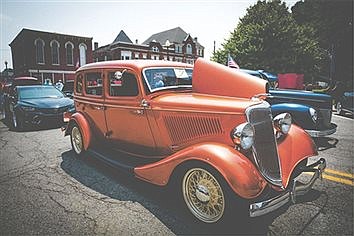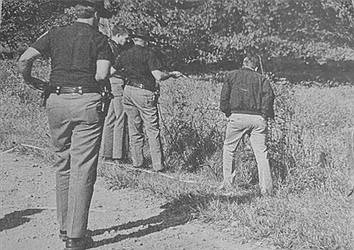School board discusses facility updates
August 10, 2022 at 6:04 p.m.

Union County College Corner Joint School District Board of Trustees reviewed updates from Performance Services on the district's facility upgrade projects at its Aug. 8 meeting.
Performance Services business development manager Tony Kuykendall and project manager Chris Burdine discussed projects they have been working on over the summer, headlined by the Union County High School solar project. The installation is complete, Performance is now waiting for Duke Energy and the project's electrical contractor to initiate the system, which is expected in the next week or two.
Kuykendall explained the one megawatt solar array is situated northeast of Union County Middle School, on property that is already owned by the district and not used by a lot of different activities. The site was previously utilized as a practice soccer field, which will now take place south of the solar array. The system is routed under the football field to the high school, where it is expected to save approximately $200,000 in energy savings each year.
In order to protect the system, Performance installed drainage tile in the field where the solar array is located, extending south past the planned practice soccer field. Kuykendall noted drainage was a concern with the location and wanted to ensure the solar array would not exacerbate the problem. A six-foot fence was installed, topped with barbed wire.
The on-campus solar array will offer education opportunities to Union County schools and Performance partnered with the National Energy Education Development (NEED) Project to bring resources to the district's teachers. Once the system is up and running, NEED will dispatch a team of teachers to train local teachers.
Board member Jessica Jones asked if there were any safety concerns locating the soccer practice field so close to the solar array. Kuykendall replied “there are none that we are aware of.” Performance’s engineering team has researched the safety of solar systems on school campuses and have found no concerns. Kuykendall offered to try to find an alternate location for the soccer field, but Performance's recommendation is not to. Board member Michele Hill asked if there were any durability concerns from soccer balls. Kuykendall replied soccer ball impacts would not be a problem for the solar panels. They have seen some damaged panels result from direct baseball impacts, but not with soccer balls.
Burdine took over, reviewing the remainder of the district's upgrades managed by Performance. Burdine explained they run into several supply chain delays, which they recognized would be a problem early in the process. Those upgrades include restroom remodels which are in progress and expected to be wrapped up soon, football field lights have been installed and HVAC upgrades are pushed into the fall.
Peformance had planned to resurface the district's tennis courts under the current round of renovations; however, after inspecting the courts in the spring, they found the courts in need of a more significant repair and referred the district to athletic facility architecture firm Context Design. Fred Prazeau of Context Design first discussed replacement options with the board in April where he explained the ground below the courts has become unstable and must be addressed. Prazaeu presented three options to address the issue: dig out the existing court and rebuild asphalt courts after stabilizing the ground, build a reinforced, structural concrete slab on top of the unstable ground or build courts in a new location.
Since then, Context has completed a topographical survey of the campus and developed a series of alternate location options for the board to consider, mostly located south of UCMS. If the board chooses to rebuild in the same location, the construction window is long enough it will disrupt either spring or fall tennis; seasons would not be interrupted if courts are built in a new location.
Jones voiced concern over the cost of a tennis court replacement and asked how much longer the current courts can be used. Prazaeu replied the courts no longer meet any competitive standard and are beyond their usable life. There are a number of soft spots; if one develops into a toe-catch, it could pose an injury risk. Jones noted the concern of injury in the current courts and asked if they should even be in use; she asked if there are any options to hold the school's tennis program off-site.
UCHS athletic director Ryan Overholt replied that has been done in the past, specifically recalling a time when the teams were hauled down to Franklin County; although he warned bus availability could be a problem.
“I don't know if I'm the only one leery of this project, but it's kept me up at night thinking about the amount of money that we're going to spend on tennis courts … I think there's some safety measures that really always should have to trump these kinds of things,” said Jones.
Discussion revealed some of Performance's upgrades were put on the back burner to make room for the increased cost of the tennis court repairs, including some upgraded security door handles.
Prazaeu proceeded to review the proposed locations where new tennis courts could be located. The locations are primarily located south of UCMS, balancing the proximity to S.R. 44, a residence to the southeast and potential drainage issues to the east.
Board vice-president Grace Atkins asked what the current construction estimates are. Prazaeu replied to rebuild asphalt courts on the current site would run in the $800,000s, maybe into the $900,000s, based on recent bids he's reviewed for similar projects. He does not expect to see a significant difference in cost to build in a new location. Prazaeu warned remediation of the subgrade to ensure the old court location is stable is a yet unknown, and potentially, expensive cost. Installing a stressed concrete slab over the existing court would be more expensive, but would not require the same stabilization efforts, likely reducing the gap. Concrete courts have a life expectancy nearly double that of asphalt, potentially making it the most cost effective option. The board agreed to put the project out for bids, seeking pricing on a few different options.
Latest News
E-Editions
Events
Union County College Corner Joint School District Board of Trustees reviewed updates from Performance Services on the district's facility upgrade projects at its Aug. 8 meeting.
Performance Services business development manager Tony Kuykendall and project manager Chris Burdine discussed projects they have been working on over the summer, headlined by the Union County High School solar project. The installation is complete, Performance is now waiting for Duke Energy and the project's electrical contractor to initiate the system, which is expected in the next week or two.
Kuykendall explained the one megawatt solar array is situated northeast of Union County Middle School, on property that is already owned by the district and not used by a lot of different activities. The site was previously utilized as a practice soccer field, which will now take place south of the solar array. The system is routed under the football field to the high school, where it is expected to save approximately $200,000 in energy savings each year.
In order to protect the system, Performance installed drainage tile in the field where the solar array is located, extending south past the planned practice soccer field. Kuykendall noted drainage was a concern with the location and wanted to ensure the solar array would not exacerbate the problem. A six-foot fence was installed, topped with barbed wire.
The on-campus solar array will offer education opportunities to Union County schools and Performance partnered with the National Energy Education Development (NEED) Project to bring resources to the district's teachers. Once the system is up and running, NEED will dispatch a team of teachers to train local teachers.
Board member Jessica Jones asked if there were any safety concerns locating the soccer practice field so close to the solar array. Kuykendall replied “there are none that we are aware of.” Performance’s engineering team has researched the safety of solar systems on school campuses and have found no concerns. Kuykendall offered to try to find an alternate location for the soccer field, but Performance's recommendation is not to. Board member Michele Hill asked if there were any durability concerns from soccer balls. Kuykendall replied soccer ball impacts would not be a problem for the solar panels. They have seen some damaged panels result from direct baseball impacts, but not with soccer balls.
Burdine took over, reviewing the remainder of the district's upgrades managed by Performance. Burdine explained they run into several supply chain delays, which they recognized would be a problem early in the process. Those upgrades include restroom remodels which are in progress and expected to be wrapped up soon, football field lights have been installed and HVAC upgrades are pushed into the fall.
Peformance had planned to resurface the district's tennis courts under the current round of renovations; however, after inspecting the courts in the spring, they found the courts in need of a more significant repair and referred the district to athletic facility architecture firm Context Design. Fred Prazeau of Context Design first discussed replacement options with the board in April where he explained the ground below the courts has become unstable and must be addressed. Prazaeu presented three options to address the issue: dig out the existing court and rebuild asphalt courts after stabilizing the ground, build a reinforced, structural concrete slab on top of the unstable ground or build courts in a new location.
Since then, Context has completed a topographical survey of the campus and developed a series of alternate location options for the board to consider, mostly located south of UCMS. If the board chooses to rebuild in the same location, the construction window is long enough it will disrupt either spring or fall tennis; seasons would not be interrupted if courts are built in a new location.
Jones voiced concern over the cost of a tennis court replacement and asked how much longer the current courts can be used. Prazaeu replied the courts no longer meet any competitive standard and are beyond their usable life. There are a number of soft spots; if one develops into a toe-catch, it could pose an injury risk. Jones noted the concern of injury in the current courts and asked if they should even be in use; she asked if there are any options to hold the school's tennis program off-site.
UCHS athletic director Ryan Overholt replied that has been done in the past, specifically recalling a time when the teams were hauled down to Franklin County; although he warned bus availability could be a problem.
“I don't know if I'm the only one leery of this project, but it's kept me up at night thinking about the amount of money that we're going to spend on tennis courts … I think there's some safety measures that really always should have to trump these kinds of things,” said Jones.
Discussion revealed some of Performance's upgrades were put on the back burner to make room for the increased cost of the tennis court repairs, including some upgraded security door handles.
Prazaeu proceeded to review the proposed locations where new tennis courts could be located. The locations are primarily located south of UCMS, balancing the proximity to S.R. 44, a residence to the southeast and potential drainage issues to the east.
Board vice-president Grace Atkins asked what the current construction estimates are. Prazaeu replied to rebuild asphalt courts on the current site would run in the $800,000s, maybe into the $900,000s, based on recent bids he's reviewed for similar projects. He does not expect to see a significant difference in cost to build in a new location. Prazaeu warned remediation of the subgrade to ensure the old court location is stable is a yet unknown, and potentially, expensive cost. Installing a stressed concrete slab over the existing court would be more expensive, but would not require the same stabilization efforts, likely reducing the gap. Concrete courts have a life expectancy nearly double that of asphalt, potentially making it the most cost effective option. The board agreed to put the project out for bids, seeking pricing on a few different options.





